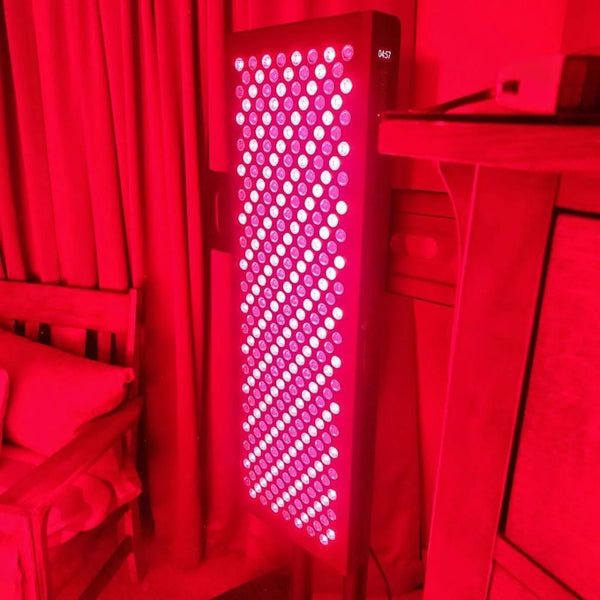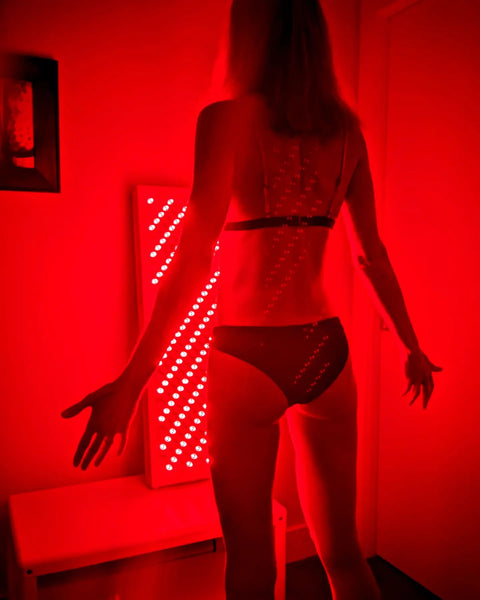
Red Light Therapy for Lymphedema: Enhancing Lymphatic System Health
Red Light Therapy for Lymphatic Drainage
Red light therapy has become super popular for treating skin, muscles, and even pain. But did you know it can also help improve how your body removes toxins and excess fluid? In this blog post, we’ll explore how red light therapy for lymphatic drainage can boost your overall health by improving your body’s natural detox process.
Benefits of Red Light Therapy for Lymphatic Drainage
Red light therapy for lymphedema offers several benefits for people looking to improve their lymphatic drainage. Whether you're dealing with swelling, detoxing, or just trying to boost your overall health, this therapy can make a big difference.
Red light penetrates the surface of the skin and provides the cells with usable energy, providing multiple benefits, such as an increase in ATP production.
1. Reduces Swelling and Puffiness

One of the most immediate benefits is the reduction of swelling and puffiness. Red light helps your body move excess fluid, which often builds up in areas like your legs, arms, or face. This is particularly helpful for people who experience bloating or swelling after long periods of sitting or standing.
2. Boosts Circulation

Red light therapy improves circulation, helping your blood and lymphatic fluid flow more easily. Better circulation means your body can get rid of waste and toxins faster. This also helps reduce the feeling of heaviness or tightness in areas affected by poor lymphatic drainage.
3. Supports Immune Health

Since the lymphatic system is part of your body’s immune defense, keeping it working properly means you’re better equipped to fight off infections. Red light therapy helps the lymphatic system work more efficiently, allowing your body to flush out harmful substances and stay healthy.
4. Enhances Post-Surgery Recovery

Many people use red light therapy to speed up healing after surgery. It can reduce swelling and bruising, which is common when the lymphatic system is working overtime to heal a surgical area. By using red light therapy, people can recover faster and feel more comfortable during the healing process.
5. Eases Chronic Conditions

For people with chronic issues like lymphedema or inflammation throughout the body, red light therapy provides relief by improving fluid movement and reducing the buildup of toxins. This can help manage symptoms like pain, stiffness, and swelling that come with these conditions.
What is the Lymphatic System and Why is It Important?
Overview of the Lymphatic System
The lymphatic vessel system is like your body’s cleanup crew. It moves excess fluid, toxins, and waste out of your tissues and into your bloodstream, where they can be flushed out. Think of it as your body’s natural drainage system.
- Detox: It helps get rid of things your body doesn’t need, like bacteria and waste.
- Fluid balance: Keeps your body’s fluid levels balanced by draining excess fluid.
- Immune support: Helps fight infections by moving white blood cells through your body.
Common Issues with Lymphatic Drainage
Sometimes, this system gets a little sluggish, especially if you’re not very active. This can lead to problems like:
- Swelling: You may notice puffiness in areas like your legs or arms.
- Fatigue: Feeling tired all the time is a common sign your lymphatic system might need some help.
- Frequent colds: When your lymphatic system isn’t working well, your body can’t fight off infections as easily.
Keeping your lymphatic system moving smoothly is key for staying healthy, and this is where red light therapy can really help.
What is Red Light Therapy?
Red and near-infrared therapy is a simple, non-invasive treatment that uses low-level wavelengths of red light to improve various health conditions. It’s like giving your body a little energy boost! The light penetrates your skin and reaches your cells, helping them work better and heal faster.
Many people use red light therapy for skin issues, pain relief, and muscle recovery. But it’s also great for improving your body’s ability to detox by boosting the lymphatic system.
How Red Light Therapy Works for Lymphatic Drainage
When infrared light hits your skin, it stimulates your cells to produce more energy. This increased energy helps your lymphatic system move fluid and waste more efficiently, which can reduce swelling and puffiness. It’s like turning up the power in your body’s natural detox system.
By helping to move lymphatic fluid more easily, red light therapy can:
- Reduce inflammation and swelling in areas like your legs, arms, and face.
- Boost circulation, which helps get rid of toxins faster.
- Support your immune system, making it easier for your body to fight infections.
It’s a gentle and relaxing way to improve how your body works on the inside.
How to Use Red Light Therapy for Lymphatic Drainage
If you’re ready to try red light therapy for lymphatic drainage, you’ll be happy to know it’s easy to use and can be done right at home with the right device. Here’s how to get started:
1. Choosing the Right Device
There are many red light therapy devices available, from small handheld devices to large panels. When picking one for lymphatic drainage, consider:
- Size: Larger panels cover more area, making it easier to treat larger parts of your body, like your legs or abdomen.
- Power: Look for devices with sufficient power output (measured in milliwatts per square centimeter (mW/cm2)) to penetrate deeply into your tissues.
- Wavelengths of light: Most effective red light devices use wavelengths between 600 and 650 nanometers (nm) for skin-level benefits, and around 800 to 850 nm for deeper tissue penetration.
2. Frequency and Duration of Sessions
How often and how long you should use red light therapy depends on your goals:
- For lymphatic drainage, aim for 10 to 20 minutes per session, 3 to 5 times per week.
- Make sure to give each targeted area enough time under the light to receive the benefits. It’s important to stay consistent for the best results.
3. Targeting Specific Areas
Certain areas of the body are more prone to lymph fluid buildup and benefit the most from red light therapy. Here’s a simple guide for targeting different areas:
| Area | Recommended Use |
|---|---|
| Legs | Use red light on swollen legs or ankles to reduce fluid retention and improve circulation. |
| Abdomen | Apply to the lower abdomen for detox and fluid drainage. |
| Arms and Underarms | Target the lymph nodes in the armpits for better fluid movement. |
| Face and Neck | Red light can reduce puffiness in the face and neck, especially around the lymph nodes under the jawline. |
Most research on red light therapy and lymphedema has focused on breast cancer patients.
4. Tips for Best Results
- Stay hydrated: Drinking water helps your lymphatic system flush out toxins more effectively.
- Combine with movement: Physical therapy like gentle massage or stretching before or after red light therapy can further encourage lymphatic drainage.
- Consistency is key: Just like with any therapy, sticking to a regular routine will help you see better, longer-lasting results.
Are There Any Risks or Side Effects?
Red light therapy is generally considered a safe and gentle treatment with very few risks or side effects. Most people can use it without any issues, but like any treatment, it’s always good to be aware of possible concerns.
1. Common Side Effects
Although rare, some people may experience mild side effects after using red light therapy, such as:
- Skin redness: Some users report slight redness on the skin after using red light therapy, especially if the light was too close or the session was too long.
- Eye sensitivity: Since the light is quite bright, it’s important to avoid staring directly at the red light. Using protective goggles during treatment can help protect your eyes.
2. Who Should Avoid Red Light Therapy?
While red light therapy is safe for most people, certain groups should consult with a doctor before using it:
- Pregnant women: There isn’t enough research yet on the effects of red light therapy during pregnancy, so it’s best to talk to your healthcare provider first.
- People with light sensitivity: Those who have conditions or take medications that make their skin more sensitive to light should be cautious and may want to avoid this treatment.
3. Safe Practices for Red Light Therapy
To ensure you get the benefits without any downsides, follow these best practices:
- Follow device instructions: Always use your red light therapy device according to the manufacturer’s guidelines to avoid overuse or skin irritation.
- Start slow: If you’re new to red light therapy, start with shorter sessions and gradually increase the duration as your body adjusts.
- Protect your eyes: Use eye protection if you’re treating areas close to your face.
For most people, red light therapy for lymphatic drainage is safe and easy to use with no major risks. It’s a non-invasive way to improve your health without the worry of significant side effects.
FAQ Section
Is LED light therapy safe for everyone?
Yes, red light therapy is generally safe for most people. However, pregnant women and individuals with light-sensitive conditions or medications should consult a healthcare provider before starting treatment. Always follow device instructions and avoid staring directly into the light.
How quickly can I see results with red light therapy for lymphatic drainage?
Results can vary depending on the person and the severity of the issue. Many people notice reduced swelling and improved circulation after just a few sessions. For best results, it’s recommended to use red light therapy consistently over a few weeks.
Can I use red light therapy at home, or do I need professional treatment?
You can absolutely use red light therapy at home! There are many high-quality devices available for personal use. Just make sure to choose a device with the specific wavelengths of light and follow the recommended usage guidelines. Professional treatments are also an option if you prefer a clinical setting.
What’s the best red light therapy device for lymphatic drainage?
The best device depends on your needs. For larger areas like your legs or abdomen, a panel is a good option. Handheld devices are great for smaller areas like the face or neck. Look for devices with wavelengths between 600-850 nm, as this range is known to penetrate the skin deeply enough to support lymphatic drainage.
How long should I use red light therapy for lymphatic drainage each session?
Typically, a session should last between 10-20 minutes per targeted area, with 3-5 sessions per week being ideal. It’s important to follow the manufacturer’s guidelines to ensure you’re using the device properly and not overdoing it.
Can red light therapy be used with other treatments for lymphatic drainage?
Yes! Red light therapy works well alongside other treatments like exercise, manual lymphatic drainage, and compression therapy. In fact, combining these methods can enhance the overall effectiveness of improving your lymphatic system’s function.
Conclusion
Red light therapy for lymphatic drainage is a powerful yet gentle way to support your body’s natural detox and fluid management systems. By boosting circulation, reducing swelling, and helping your lymphatic system function more efficiently, red light therapy can improve your overall health and well-being.
Whether you’re dealing with chronic conditions like lymphedema, recovering from surgery, or just looking to enhance your body's detox process, red light therapy offers a convenient, non-invasive solution you can use at home. With consistent use and the right technique, you can experience noticeable benefits in how your body feels and functions.
For best results, consider combining red light therapy with other healthy habits, like staying hydrated, regular exercise, and maintaining a balanced diet. And remember, consistency is key—stick to a routine and give your body time to respond.
If you’re ready to try red light therapy, start small, choose the right device, and enjoy the health benefits that come from improved lymphatic drainage.




